
|
Astronomy Picture Of the Day (APOD)
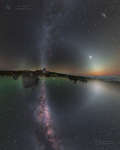 Two Hemisphere Night Sky
Two Hemisphere Night Sky
26.02.2020
The Sun is hidden by a horizon that runs across the middle in this two hemisphere view of Earth's night sky. The digitally stitched mosaics were recorded from corresponding latitudes, one 29 degrees north and one 29 degrees south of the planet's equator.
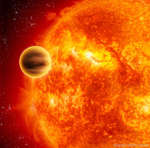 NGST 10b: Discovery of a Doomed Planet
NGST 10b: Discovery of a Doomed Planet
25.02.2020
This hot jupiter is doomed. Hot jupiters are giant planets like Jupiter that orbit much closer to their parent stars than Mercury does to our Sun. But some hot jupiters are more extreme than others. NGTS-10b, illustrated generically, is the closest and fastest-orbiting giant planet yet discovered, circling its home star in only 18 hours.
 Jupiters Magnetic Field from Juno
Jupiters Magnetic Field from Juno
24.02.2020
How similar is Jupiter's magnetic field to Earth's? NASA's robotic Juno spacecraft has found that Jupiter's magnetic field is surprisingly complex, so that the Jovian world does not have single magnetic poles like our Earth.
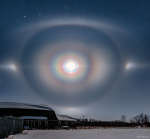 Moon Corona, Halo, and Arcs over Manitoba
Moon Corona, Halo, and Arcs over Manitoba
23.02.2020
Yes, but could you get to work on time if the Moon looked like this? As the photographer was preparing to drive to work, refraction, reflection, and even diffraction of moonlight from millions of falling ice crystals turned the familiar icon of our Moon into a menagerie of other-worldly halos and arcs.
 Illustris Simulation of the Universe
Illustris Simulation of the Universe
22.02.2020
How did we get here? Click play, sit back, and watch. A computer simulation of the evolution of the universe provides insight into how galaxies formed and perspectives into humanity's place in the universe.
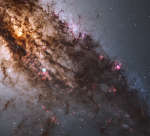 Central Centaurus A
Central Centaurus A
21.02.2020
A mere 11 million light-years away, Centaurus A is the closest active galaxy to planet Earth. Also known as NGC 5128, the peculiar elliptical galaxy is over 60,000 light-years across. A region spanning about 8,500 light-years, including the galaxy's center (upper left), is framed in this sharp Hubble Space telescope close-up.
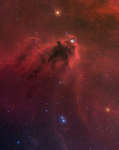 LDN 1622: Dark Nebula in Orion
LDN 1622: Dark Nebula in Orion
20.02.2020
The silhouette of an intriguing dark nebula inhabits this cosmic scene. Lynds' Dark Nebula (LDN) 1622 appears against a faint background of glowing hydrogen gas only visible in long telescopic exposures of the region. In contrast, the brighter reflection nebula vdB 62 is more easily seen, just above and right of center.
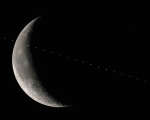 Trifecta at Twilight
Trifecta at Twilight
19.02.2020
On February 18, as civil twilight began in northern New Mexico skies, the International Space Station, a waning crescent Moon, and planet Mars for a moment shared this well-planned single field of view. From...
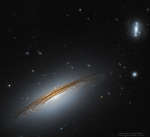 UGC 12591: The Fastest Rotating Galaxy Known
UGC 12591: The Fastest Rotating Galaxy Known
18.02.2020
Why does this galaxy spin so fast? To start, even identifying which type of galaxy UGC 12591 is difficult -- featured on the lower left, it has dark dust lanes like a spiral galaxy but a large diffuse bulge of stars like a lenticular.
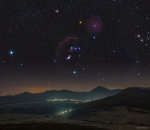 Orion over the Central Bohemian Highlands
Orion over the Central Bohemian Highlands
17.02.2020
Do you recognize this constellation? Setting past the Central Bohemian Highlands in the Czech Republic is Orion, one of the most identifiable star groupings on the sky and an icon familiar to humanity for over 30,000 years.
|
January February March April May June July August September October November December |
|||||||||||||||||||||||||||||||||||||||||||||||||